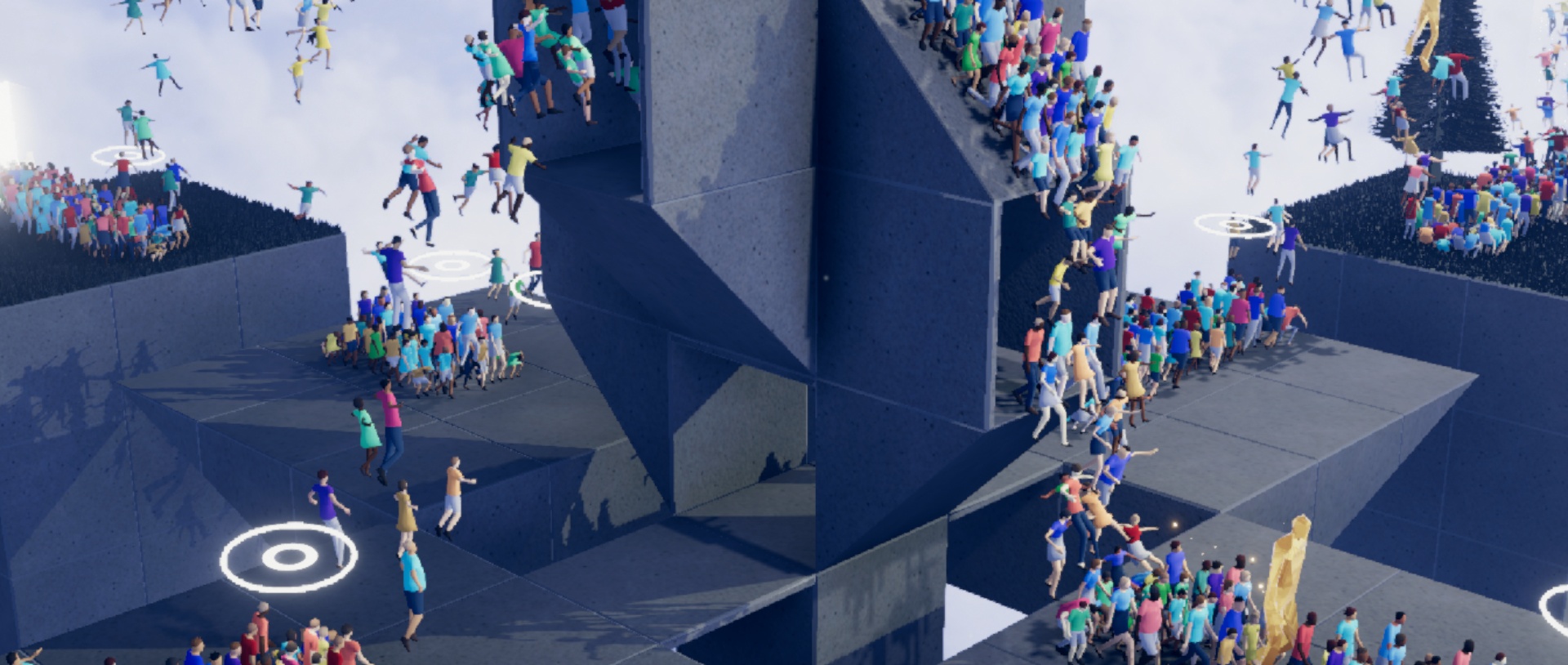Humanity takes the idea 'Lemmings but with people' and turns it into something profound
Humanity's screenfulls of little people create striking images, but there's also a great puzzle game beneath the art.

Before I declare Humanity a new member of the Videogames As Art canon, I should confess that I know embarrassingly little about art. My mom is an artist and has worked in art galleries for most of my life. My dad is a photographer. I like and appreciate art, but I have no vocabulary for it—I spent half the time I should've been writing this preview of a brilliant videogame trying to decide if it was an expression of futurism, or constructivism, or minimalism.
Did you know there's a post-minimalism? I should try my hand at being a post-post-minimalist writer and turn in an empty page next time I'm on a deadline. But that wouldn't be fair to Humanity, which I've been playing nightly for the last couple weeks.
Perhaps this is a more useful aesthetic reference point: Humanity is an early-2000s physics tech demo turned into a proper game. It unabashedly pairs philosophical musings on life and war with block-pushing puzzles, like a different strain of Keita Takahashi's Katamari Damacy.
Humanity has real "they don't make 'em like they used to" vibes, which publisher Enhance played into with an ad paying homage to the bizarre PlayStation commercials of the '90s and '00s. But honestly, what makes Humanity great is that they couldn't make them like this back in the day. What I mostly love about it is how it can fill the screen with hundreds upon hundreds of little low-poly people, rivers of bodies endlessly flowing around the cubey maps without a frame drop in sight.
The hub world is a pure physics playground, a white space where more bodies than you can count mill about and the crowds part as your shiba inu spirit guide dashes between them.
Like PC puzzle great Opus Magnum, Humanity is at its most fun when you take your hands off the controls and watch what you've designed. Mostly that's the careful placement of a dozen or so commands, telling your endless streams of bodies where to turn, turn again, jump, push a block, and climb to a glowing pedestal that beams them up to the next stage of the afterlife in a column of light.

Humanity quickly and repeatedly changes up how you guide your flock to the end goal of a level. Some levels employ conveyor floors and giant fans to harry your path. Others give you a limited number of each command, and keep the level in suspended animation until you press start; you're no longer allowed to place commands until you watch your solution play out or smack reset. These, along with the levels that have you spending all your time pushing blocks into place, are my least favorite—they sometimes dip into tedium or get in the way of the mesmerizing flowing crowds.
Keep up to date with the most important stories and the best deals, as picked by the PC Gamer team.
But Humanity never dwells on any one idea for too long.
Some of the best puzzles pit you against another army of faceless people all clad in black, who will beat your crowd senseless or mow them down with guns when you get close. These levels slyly ask you to manipulate Humanity's physics by splitting your forces into multiple streams, feeling out how to outmaneuver the mindless enemy before your own numbers are overrun.

My favorite saw our two hordes smashing into each other in an endless dead heat until I re-routed my single line of gunmen across a bridge where they could provide covering fire, while I pooled a thousand baton-wielders into a corner and then unleashed them in one gigantic wave to overrun the enemy spawn points.
There's such innately videogamey playfulness to most of these levels that I'm still sometimes taken aback by how pretty it is to watch. Like Enhance's last game, Tetris Effect, these simple colors and shapes are imbued with a sense of meaningfulness that's hard to articulate. You can imagine Humanity projected on the wall of the Museum of Modern Art, yet it can still count Lemmings and freaking Q*bert among its ancestors.
Humanity accomplishes this feat because it knows that its swarms of low-poly people are the star, and nearly every puzzle is in service of watching their bodies move in unison. When you play Humanity (and you really, really should) and find yourself stumped, just try to picture the solution that M.C. Escher would come up with. If you'd linger on the level to watch its infinite loop instead of hurrying onto the next, you and humanity are both on the right track.

Wes has been covering games and hardware for more than 10 years, first at tech sites like The Wirecutter and Tested before joining the PC Gamer team in 2014. Wes plays a little bit of everything, but he'll always jump at the chance to cover emulation and Japanese games.
When he's not obsessively optimizing and re-optimizing a tangle of conveyor belts in Satisfactory (it's really becoming a problem), he's probably playing a 20-year-old Final Fantasy or some opaque ASCII roguelike. With a focus on writing and editing features, he seeks out personal stories and in-depth histories from the corners of PC gaming and its niche communities. 50% pizza by volume (deep dish, to be specific).

